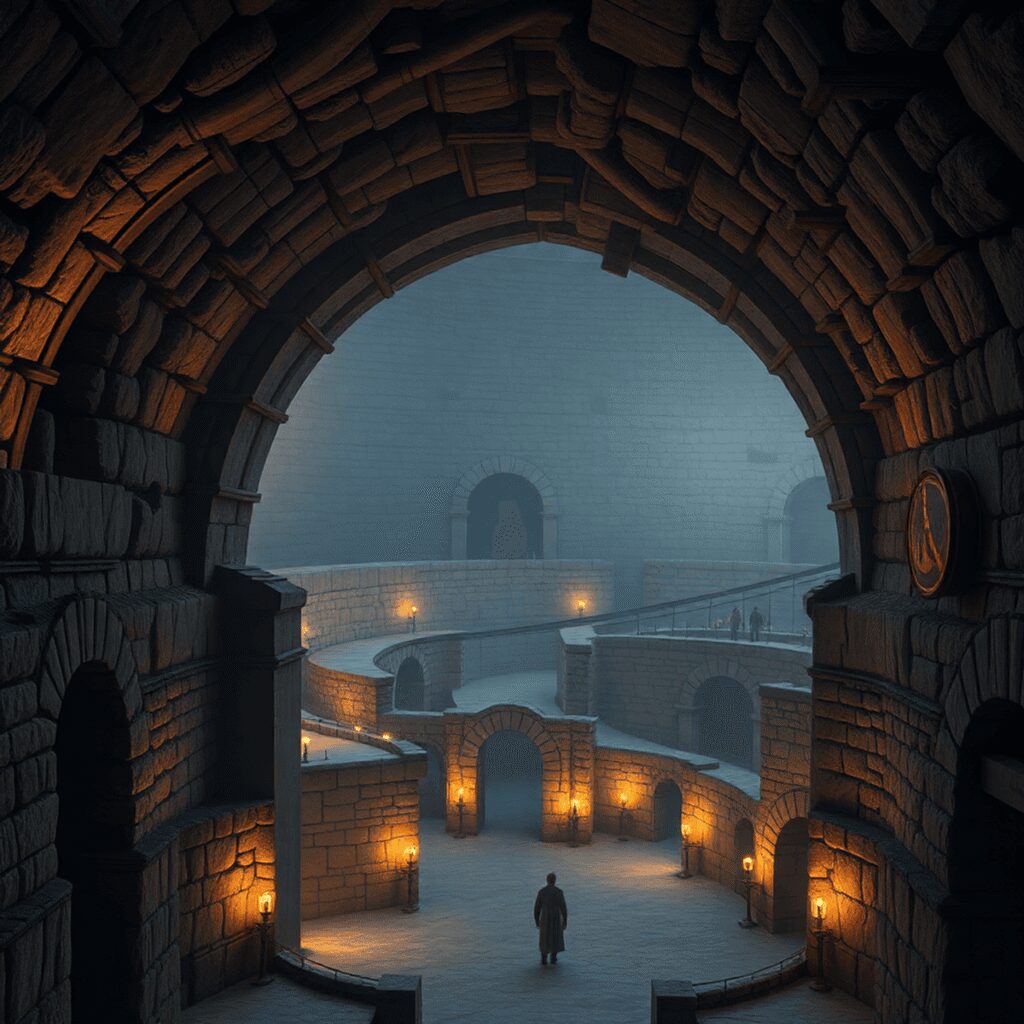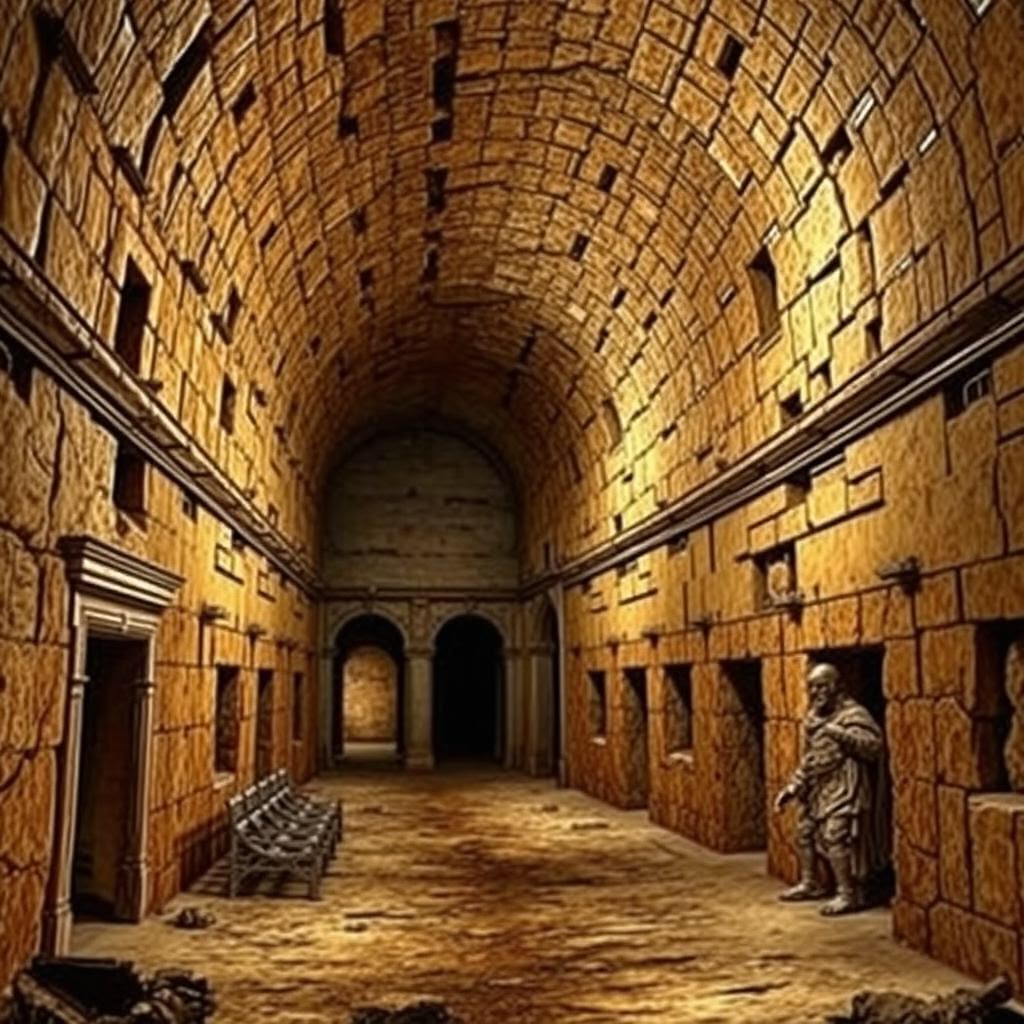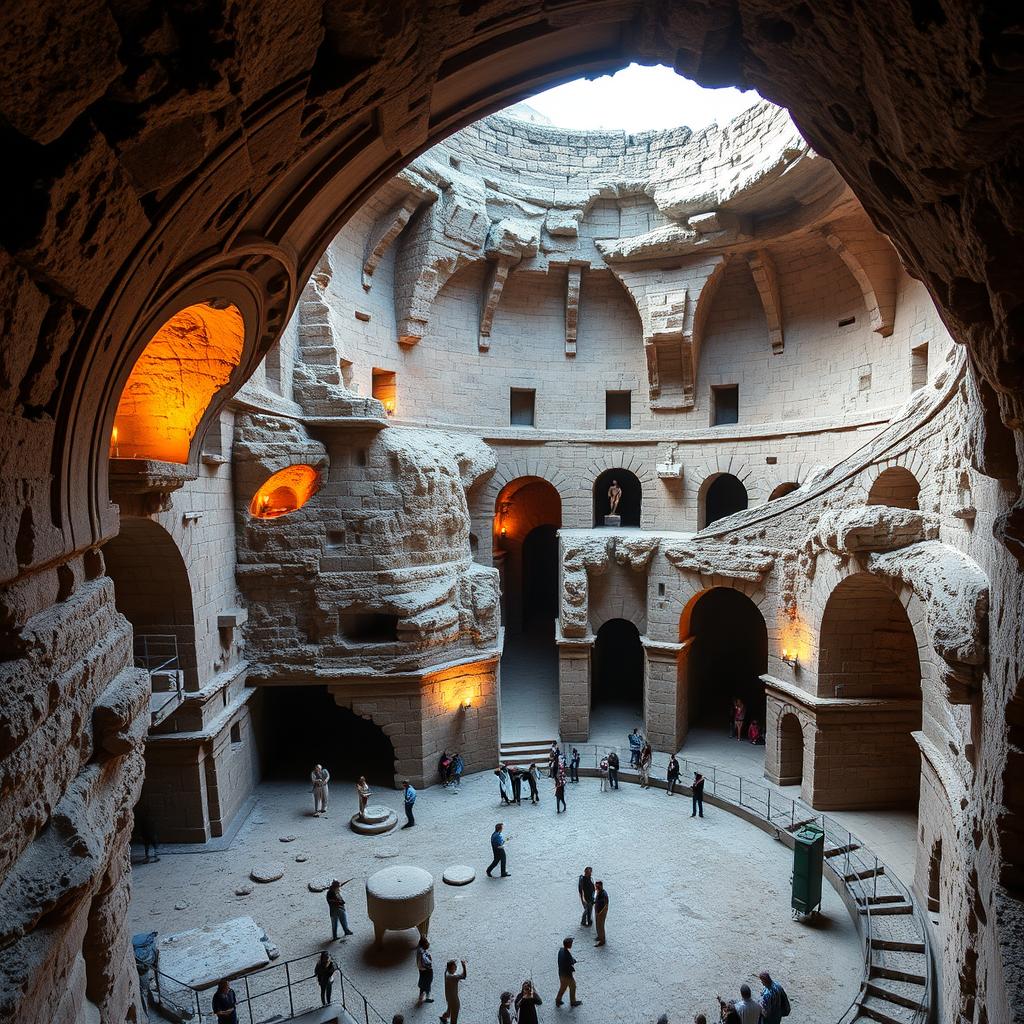Beneath Rome’s great arenas lies a hidden world few get to see—the secret tunnels known as the hypogeum. These underground passages were not just functional spaces but vital components in staging the spectacular events that defined ancient Roman entertainment. The hypogeum served as a stage beneath the stage, where gladiators, wild animals, and elaborate scenery were prepared and suddenly unleashed into the arena above.
Exploring these tunnels reveals much about Roman engineering, culture, and social dynamics. Understanding the hypogeum provides insight into how Romans managed complex logistics for massive crowds and dramatic performances. It also highlights their innovative use of machinery and design long before modern technology existed.
The history behind these secret tunnels is as fascinating as the arenas they supported. Built to amaze spectators and ensure smooth operation of brutal games, the hypogeum reflects both the grandeur and the harsh realities of ancient Rome. Beneath iconic structures like the Colosseum, this network of corridors offers a rare glimpse into an underground world that shaped public spectacle.
You will discover how these tunnels functioned, how they connected to other parts of Rome, and why preserving them remains crucial today. The story of Rome’s hypogeum continues to captivate historians, archaeologists, and visitors alike.
In addition to exploring these historical aspects, one can also engage with the world of Romanum in Second Life, where players immerse themselves in a virtual representation of ancient Rome. This blend of history and modern technology allows for a unique exploration of Roman culture and society.
Moreover, understanding the influence of Roman mythology on modern culture can provide deeper insights into how these ancient narratives continue to shape our societal norms and political aspirations today.
Lastly, it’s essential to acknowledge the role of the Roman army in shaping the empire’s vastness. Their military might was not just a symbol of power but also a critical factor in achieving victories across large territories.

The Hypogeum: Engineering Marvel of Ancient Rome
Beneath the iconic Colosseum in Rome lies a remarkable engineering feat known as the Hypogeum. This intricate network of underground passages served a variety of functions that were crucial to the grand spectacles, such as gladiator fights, held in the great arenas of ancient Rome.
1. Purpose and Design
The primary purpose of the Hypogeum was to support the elaborate events and games that took place in the Colosseum. It housed essential facilities such as stage machinery, armories, cages for wild animals, and holding cells for gladiators and prisoners.
2. Functionality
The underground tunnels beneath Rome’s arenas were designed to enable seamless transitions during the spectacles. Elevators and trapdoors operated by slaves allowed for swift movements of gladiators, animals, and scenery into the arena, creating an element of surprise and enhancing the dramatic effect of the games.
3. Role of Roman Architects
Skilled Roman architects played a pivotal role in creating this intricate network. Their innovative designs not only facilitated the smooth functioning of events but also showcased their advanced engineering capabilities.
The Hypogeum stands as a testament to the architectural ingenuity of ancient Rome, providing valuable insights into both the functional aspects and artistic intricacies of these underground structures. This architectural marvel is just one example of how ancient Rome’s legacy continues to shape Western civilization today.
For those interested in delving deeper into this fascinating era, Men of Pompeii offers a wealth of resources spanning from its origins as a Republic to its transformation into a mighty Empire.
Features of the Hypogeum
The hypogeum’s design included sophisticated mechanisms for raising gladiators and wild animals into the arena, creating a powerful spectacle that captivated Roman audiences. Central to these operations were:
- Elevators: Large wooden platforms operated by a system of pulleys and counterweights. These elevators could swiftly lift cages containing fierce beasts or gladiators waiting below, allowing sudden and dramatic entrances during events.
- Trapdoors: Strategically placed throughout the arena floor, trapdoors opened to reveal surprises—whether a gladiator appearing out of nowhere or an animal springing into the action. This added unpredictability and theatrical flair to the games.
Supporting this machinery was an advanced hydraulic infrastructure. Water-powered systems assisted in moving heavy loads and operating lifts smoothly. The Romans engineered channels and reservoirs beneath the hypogeum to regulate water pressure essential for these hydraulic mechanisms.
The combination of elevators, trapdoors, and hydraulic systems transformed the arena into a dynamic stage. This allowed organizers to choreograph complex scenes—switching between combatants, animals, and scenery with remarkable speed and precision. These features made each event not just a fight but a carefully orchestrated performance, showcasing Roman ingenuity in both engineering and entertainment.
However, it’s essential to remember that behind these spectacles were gladiators, who lived a life filled with peril and uncertainty. They were brave warriors admired for their skills in battle, yet they were also victims of a complex social system that exploited their talents for entertainment.
Moreover, the structuring of such events was not merely an exercise in entertainment; it was also governed by Roman law, which has played a crucial role in shaping modern legal systems. Understanding this legacy is essential for grasping the foundations of contemporary laws.

Connection to Other Parts of Rome
The hypogeum’s design extended beyond the arena itself, integrating with other crucial parts of ancient Rome through a series of secret passages. One of the most important connections was with the Ludus Magnus, the primary gladiator training school located just east of the Colosseum. This link allowed gladiators to move discreetly and efficiently from their training quarters directly into the underground tunnels, readying them for combat without public exposure or delay.
These secret passages were more than simple corridors; they formed an intricate network that connected the hypogeum to various strategic points across Rome. This network included routes for transporting animals, equipment, and performers essential for the games. The tunnels ensured that operations ran smoothly and maintained an element of surprise during events.
Understanding The Secret Tunnels Beneath Rome’s Great Arenas Revealed means recognizing how these subterranean connections exemplify Roman ingenuity—not only in engineering but also in event management and urban integration. The significance of these connections lay in their role in maintaining control and security during spectacles. Gladiators and animals could be moved swiftly and safely, while officials and favored guests had protected access routes. These underground links also helped preserve the flow of events above ground by minimizing interruptions.
The daily life of individuals involved in these spectacles varied greatly depending on their social class. For instance, while gladiators trained at the Ludus Magnus, the lives of plebeians, who made up a large part of Roman society and significantly influenced political and economic structures, were vastly different. They represented a diverse group of free citizens who were not part of the patrician elite, highlighting the social class divide that characterized ancient Rome.
Moreover, these secret passages were not just limited to the Colosseum or Ludus Magnus; they were part of a larger network that included Roman roads which served as vital arteries for maintaining and expanding the empire. This extensive infrastructure facilitated not only the movement of people but also played a crucial role in shaping the rise of Stoicism in Rome, as Greek philosophy began to influence Roman thought and culture.
Safety Measures and Special Designs
The underground tunnels beneath Rome’s great arenas were not only ingeniously designed for functionality but also for safety and special effects during events:
1. Subterranean passage for protecting Emperor Commodus during events
One notable feature of the hypogeum was a specially constructed passage intended to ensure the safety of Emperor Commodus during spectacles held at the Colosseum. This subterranean route allowed the emperor to move discreetly between different areas, safeguarding him from potential threats or dangers.
2. Design elements for ensuring safety in the underground area
The architects of the hypogeum incorporated various design elements to prioritize safety within the underground complex. This included sturdy construction techniques, strategic placement of support structures, and emergency exits to evacuate performers or animals if needed.
3. Complex re-enactments facilitated by the special features
The intricate design of the hypogeum enabled complex and thrilling re-enactments of battles, myths, and other dramatic scenes that captivated Roman audiences. Trapdoors, elevators, and hidden passages allowed for seamless transitions and surprise elements during the performances, enhancing the overall spectacle of the events.

Exploration and Preservation Efforts Today
Visitors eager to explore the hidden world beneath Rome’s great arenas can take advantage of guided tours specifically designed to showcase the hypogeum’s complex network. These tours provide an intimate look at the corridors, chambers, and mechanisms that once brought ancient spectacles to life. Professional guides offer detailed explanations about the engineering feats that were part of these underground passages, along with their historical context and daily operations.
Preservation initiatives play a crucial role in maintaining the hypogeum’s integrity. Restoration projects have been carefully implemented to stabilize fragile structures and prevent further deterioration caused by time and environmental factors. These efforts ensure that the tunnels remain accessible while safeguarding their historical value for future generations.
The ongoing archaeological studies and landscape restoration efforts are vital components of these preservation initiatives. Restoration projects also have a significant impact on scholarly research. The conservation work often uncovers new archaeological findings, helping historians and archaeologists gain deeper insights into Roman architecture and entertainment practices. Improved public access resulting from these projects allows a wider audience to appreciate the ingenuity behind the hypogeum’s design.
Key aspects of current exploration and preservation include:
- Controlled visitor access through scheduled guided tours
- Structural reinforcement using modern conservation techniques
- Archaeological study facilitated by ongoing restoration work
- Collaboration between government agencies and heritage organizations
These combined efforts keep the hypogeum vibrant as both a cultural treasure and an educational resource within Rome’s rich historical landscape, a testament to the structure of power that characterized the Roman Republic.
Other Underground Sites in Rome Worth Exploring
Rome’s underground world extends far beyond the hypogeum beneath its great arenas. Several other remarkable subterranean sites offer unique insights into the city’s rich history and culture:
1. Catacombs
These extensive underground burial networks, dating from the 2nd century AD onward, served as sacred resting places for early Christians. The Catacombs of San Callisto and San Sebastiano are among the most famous. Their labyrinthine tunnels reveal frescoes, inscriptions, and tombs that tell stories of faith and persecution, reflecting the broader context of ancient Roman religion which intertwined with every aspect of their lives.
2. Necropolises
Ancient Roman necropolises, such as those found near the Appian Way, functioned as sprawling cemeteries outside the city walls. These burial grounds feature elaborate tombs and monuments that showcase Roman funerary art and societal hierarchy.
3. Subterranean Basilicas
Beneath some of Rome’s most iconic churches lie hidden basilicas built in earlier periods. The Basilica of San Clemente, for example, conceals multiple layers of religious structures from different eras, illustrating Rome’s continuous architectural evolution.
These underground sites complement The Secret Tunnels Beneath Rome’s Great Arenas Revealed by enriching your understanding of how Romans utilized subterranean spaces for purposes ranging from entertainment to worship and burial. Exploring these locations helps you grasp the layered complexity of Rome’s urban fabric—a city literally built upon its own history.
Moreover, these explorations can provide a deeper understanding of various aspects of Roman life, including their agricultural practices which were crucial for economic growth. Additionally, they can shed light on historical figures like Scipio Africanus, who played a significant role in shaping Rome’s trajectory during events like the Second Punic War. Furthermore, understanding the rise and fall of the Roman Empire can provide valuable context to these underground explorations. Lastly, delving into the legal status of Roman women can offer insights into gender dynamics in ancient Rome—an often overlooked aspect when studying its history.
Conclusion
Exploring The Secret Tunnels Beneath Rome’s Great Arenas Revealed invites you into Rome’s layered history, where every passage and chamber tells a story of ancient spectacle and innovation. These underground structures showcase remarkable architectural ingenuity, reflecting the Romans’ mastery in engineering complex systems that supported dramatic games and protected key figures.
This journey beneath the surface deepens your connection to Rome’s enduring legacy. It also sheds light on how the Corpus Juris Civilis, a significant achievement in Roman law, still influences modern legal systems. Furthermore, understanding this layered history is essential for grasping the complexities of Roman governance and its enduring impact on contemporary political structures. Additionally, it offers insights into the art and culture that thrived during this remarkable period, marked by artistic expressions heavily influenced by earlier traditions. Lastly, it provides a glimpse into the lives of the patricians, who were the wealthy elite of ancient Rome, known for their luxury and power.

